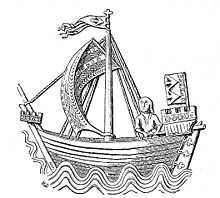Bremen cog
 | |
| Career | |
|---|---|
| Laid down: | 1380s |
| Fate: | Sank while under construction, salvaged between 1962 and 1965, currently a museum ship |
| General characteristics | |
| Class and type: | cog |
| Tonnage: | 90 tons |
| Displacement: | 55 tons |
| Length: | 23.27 m |
| Beam: | 7.62 m |
| Sail plan: | Square-rigged |
| Notes: | Dimensions taken from exhibition notes at the Hanseatic Museum in Bergen |

Bremen cog or Bremer Kogge is a well preserved wreck of a cog dated to 1380, found in 1962 in Bremen. Today it is displayed at the German Shipping Museum in Bremerhaven as one of the main features. Three nearly identical replicas of this cog have been built: Ubena von Bremen, Hansekogge and Roland von Bremen.
On 8 October 1962 during dredging operations fragments of the ship were found in the Weser River. It turned out to be the remnants of a cog that seems to have sunk during a storm flood after being drifted away from a shipyard before completion. Until then cogs had only been known from medieval documents and seals. Based on the dendrochronological analysis of the oak timber from which the cog was built the ship was dated to about 1380 AD. The search for more shipwreck fragments continued until July 1965 and yielded over 2,000 individual pieces of the ship. The fragments were transferred to the German Shipping Museum for preservation. In 1999 after 19 years of reconstruction the preservation was finished and the ship is now on display there at the designated Koggenhalle.
The Bremer cog had one mast and is square-rigged, with a carvel-built bottom and clinch-built sides. The rib timber was built in after the hull had been made.[1] The cog was 24 m long, 8 m in the beam and just over 4 m high on the sides. These measurements would have produced an estimated load capacity of 130 tons.[2] Other estimates put the cargo capacity at only 90 tons.[1]
See also
References
- ↑ 1.0 1.1 Exhibition notes, Hanseatic Museum in Bergen (2014)
- ↑ Susan Rose, The Medieval Sea, (2007)